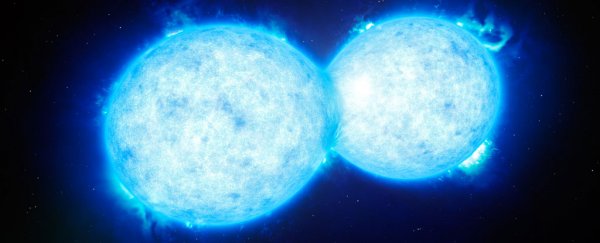Some 160,000 light-years away, two stars are overlapping one another in what has been described as a potentially catastrophic 'final kiss'.
An international team of astronomers detected the dramatic double star system using the European Space Observatory's (ESO) Very Large Telescope – not to be confused with the upcoming Extremely Large Telescope. The system, called VFTS 352, is the hottest and most massive double star system that's so far been discovered.
VFTS 352 is located in the Tarantula Nebula, which is the most active area of star formation in the Local Group of galaxies – of which the Milky Way is a part. But what's so remarkable about the system is the manner in which the stars are touching one another, sharing as much as 30 percent of their material, and generating an extreme amount of heat.
According to the researchers, the two stars orbit each other in a little over a day, and are so close together they're now touching, in what's called an 'overcontact binary'. Their centres have a distance of 12 million kilometres between them, and while that might sound like a lot, in astronomical terms it's not, especially for such massive stars.
And they really are huge. The combined mass of VFTS 352 is 57 times that of our Sun, and with all that mass comes much greater heat, with a surface temperature in excess of 40,000 degrees Celsius (whereas the Sun's surface temperature is around 5,500 degrees).
"The VFTS 352 is the best case yet found for a hot and massive double star that may show this kind of internal mixing," said Leonardo A. Almeida of the University of São Paulo in Brazil, and lead author of the study. "As such it's a fascinating and important discovery."
Cosmic intimacy between stars like this is extremely rare for scientists to find, largely because the intense proximity doesn't last for very long. In this case, the researchers say VFTS 352 faces a cataclysmic fate, with the end thought to come in one of two ways.
"If it keeps spinning rapidly it might end its life in one of the most energetic explosions in the Universe, known as a long-duration gamma-ray burst," said lead scientist Hugues Sana of the University of Leuven in Belgium.
What this would mean is the stars would keep orbiting one another and merging until they collapse into one rapidly rotating gigantic star. The second potential outcome is no less dramatic, but if it actually occurs, it would be a first for astronomical observation: the creation of a double black hole.
"If the stars are mixed well enough, they both remain compact and the VFTS 352 system may avoid merging. This would lead the objects down a new evolutionary path that is completely different from classic stellar evolution predictions," said Selma de Mink of the University of Amsterdam in the Netherlands.
"In the case of VFTS 352, the components would likely end their lives in supernova explosions, forming a close binary system of black holes. Such a remarkable object would be an intense source of gravitational waves."
The findings are published in The Astrophysical Journal.
